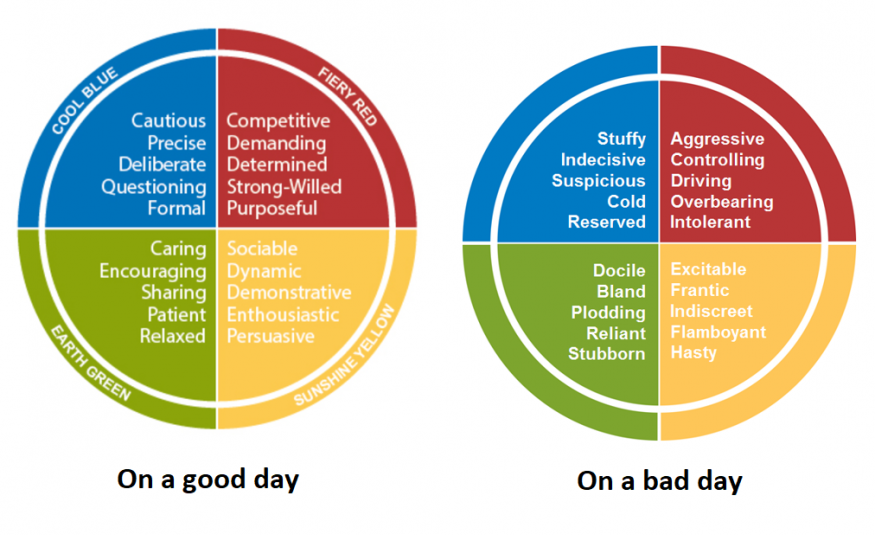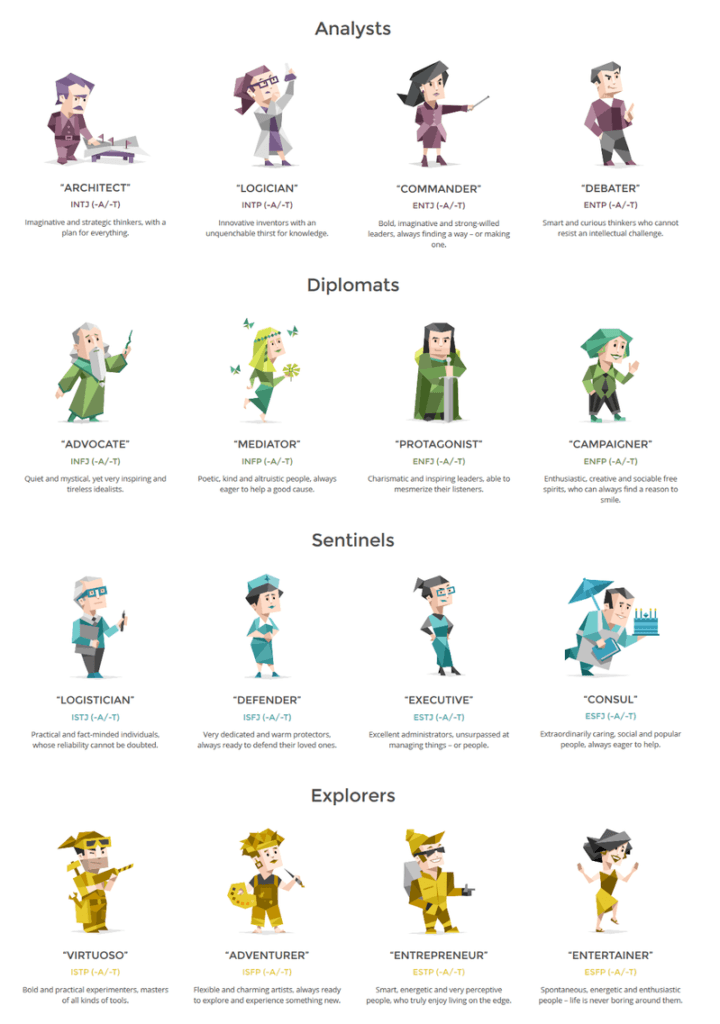We are all different as human beings, and guessing about people’s personality types is always a mystery. I will share today my experience doing a test that I did several years ago, and that helped me in that way.
In my personal experience, it started as a kind of game included inside a training. We stood up, the floor was divided into four sections, and based on questions that the coach was asking, we moved.
When the questions ended, we were standing over the section that most approached our personality, which identified a color.
But how could a simple color help us to know better the people around us?
As you may have imagined, each color is linked to a personality type. Then, what if I told you that most of us could be identified with a concrete color. And that knowing the color, you would see your strengths and weaknesses, but also, and most importantly, know others?
Our training was focused on “customer experience”, not only thinking about final customers but also internal ones. And this kind of personality classification had to allow us to identify them, to know how to manage them. Once you identify the personality of the person you have in front, you know how to treat it properly.
Treat others as you would like to be treated.
It may sound like a silly game to play, but I think it worked. And regarding its “game” part, it was the most entertaining and remembered part of the training. Everybody wanted to do the test to know its color, try to guess others, in general, wanted to know others. It was like a game, but in the end, we were knowing better people’s personalities.
Let’s do a little research about the different color – personality tests available. I will include some of them, with very little explanation, I don’t want to bore you. In case you’re interested, there will be links to tests and explanations.
Carl Jung’s personality types
Probably all modern theories and methods are based on Carl Jung’s studies. He was a well-known psychiatrist and psychoanalyst who is the father of analytical psychology.
In the book Psychological Types, Jung proposed four main functions of consciousness:
- Two perceiving or non-rational functions: Sensation and Intuition
- Two judging or rational functions: Thinking and Feeling
The functions are modified by two main attitude types: extraversion and introversion.
Jung’s theory of psychological types was not based on controlled scientific studies. As you could imagine, this generated controversy with the tests based on it.
Insights Discovery
Insights Discovery is based on the axis developed by Carl Jung. Using the “Introvert versus Extrovert” and “Thinking versus Feeling”, four quadrants can be made that describe a certain personality. Each personality is represented by a color: red, yellow, green, and blue.
- Red are extrovert thinkers.
- Yellow are extrovert feelers.
- Blue are introverted thinkers.
- Green are introverted feelers.

Substitute “On a good day” by “How I see myself”, and “On a bad day” by “How they could see me”. This is the key to adapt to others.
You’ll find a more detailed explanation here, where also you’ll read about a second step to dive deeper into the methodology, and what it is called the 8 roles.
This is probably the test we did in the training. I didn’t find any online test, but I could share it if somebody is interested.
Myers-Briggs Type indicator
I discovered this test and the 16 personalities page while doing ThePowerMBA‘s personal development section.
Myers–Briggs Type Indicator (MBTI) is an evolution of Jung’s theories. Myers-Briggs is based on four categories: Introversion/Extraversion, Sensing/Intuition, Thinking/Feeling, Judging/Perception. And the result is 16 different and unique people personalities.
I prefer not to copy all of them, so I am including the following image of the different personalities and categorizations, and I encourage you to visit the personality types page and read about them.

Also, you could find insights and descriptions inside the article A practical guide to working remotely with all 16 personality types.
Do you want to know which of the 16 personality types are you? Then, take the test!
Personality Color Indicator
Carol Ritberger defined another personality type classification using four colors: Red, Orange, Yellow, and Green. She published several books about personalities and management.
As seen on their website, the Personality Color Indicator (PCI)™ identifies predominant personality traits as they define how you gather information, process information, and make decisions.
If you want to find out your strengths, weaknesses, and physical health, you could do this quick and easy quiz here.
The scientific method and the Big Five
If the truth is told, all these tests are not science, or as some psychologists say, they are junk science, at least referring to MBTI.
Read this Adam Grant article from Psychology Today about MBTI. As a summary, we all probably agree to recognize that four letters don’t do justice to anyone’s identity.
Even if they are not science, I will stand up for these tests if they open the door of thinking about others’ personality types, try to advance our impact on each of them, and consider the blind spots. I believe this is the real usage, not just sticking into four letters that could change in time.
Anyway, as Adam also shares, other personality tests, far from perfect, were built using the scientific method. This is the case with the Big Five. The Big Five traits have high reliability and considerable power in predicting job performance and team effectiveness.
You could find the test following this link, and I encourage you to do it, think about the result, and why not share it here!
Enough for today
Maybe you never heard about them, and there are more, e.g. DISC Personality Profiling. But most are based on similar concepts and goals. All those models are not looking to evaluate skills, they are useful for knowing behaviors and evaluating preferences.
It’s important to note that there aren’t better people’s personalities or better colors than others. We have a predominant personality or color, but in general, we have different quantities of all the available functions and attitudes (we are multi-colored). Sometimes when we feel that we could fit in many of them, it could drive us to what’s called Barnum or Forer effect.
Based on those classifications you could understand and react to attitudes, affinities, or some behaviors. And regarding management, it could help you identify which kind of tasks are most suitable, which skills should be improved, and how to adapt better to others. The goal is to communicate better.
These personality tests are tools available to help. You could give them a try, even as a game. What do you think about them? Have you ever used this personality test in your work? Please, share your experiences.
I hope you liked it. If so, please share it! Do not hesitate to add your comments. And, if you want to stay up to date, don’t miss my free newsletter.
As always, thanks for reading.
